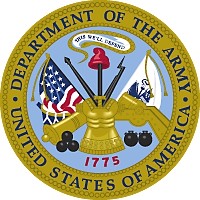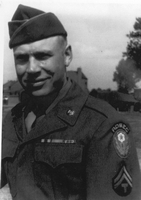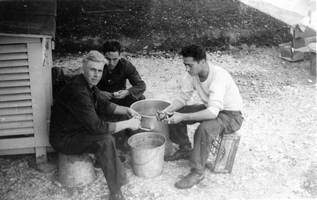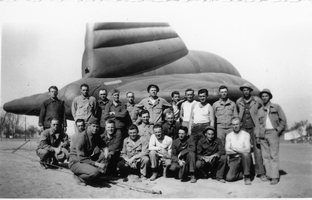
- Name: Howard Severt Landey
- Location of Birth: Morse Township, Itasca County, Minnesota
- Date of Birth: July 4, 1918
- Date of Death: July 4, 2012 (94 years old)
- Parents: John Landey, Jr. and Lena (Bertram) Landey
- High School and Class: 8th grade
- College:
- Highest Rank: TEC 5 (Technical 5)
- Branch: Army
- Other Branch:
- Date Sworn In: October 10, 1941
- Place Sworn In: Fort Snelling, Minnesota
- Date of Discharge: November 30, 1945
- Place of Discharge: Camp McCoy, Wisconsin Separation Center
-
Units and Locations:
Start Date End Date Unit(s) and Location(s) Served October, 1941 Fort Snelling, Minnesota October 18, 1941 Camp Wallace, Texas January, 1942 Camp Davis, North Carolina February, 1942 Camp Tyson, Tennessee June, 1942 Mare Island, Vallejo, California September, 1943 Fort Sheridan, Illinois October, 1943 Camp Claiborne, Louisiana February, 1944 European Theater Operation November, 1945 United States of America - Military Awards:
Rifle MKM
Good Conduct Medal
American Defense Service Ribbon
American Theater Service Ribbon
European African Middle Eastern Theater Service Ribbon
Overseas Service Bars (3)
Advance Section Shoulder Badge - Military Highlights:
Howard served with the First Army, Advance Section, 965th Engineer Maintenance Company.
Homeland Security, Mare Island, California
Normandy, Northern France, Ardennes, Rhineland
Howard served in the European Theater of Operations and took part in the D-Day Invasion landing on Omaha Beach on June 6, 1944, the Northern France Offensive (the "Break-Out"), the Battle of the Ardennes (Battle of the Bulge), and the Rhineland Offensive, earning him four battle ribbons.
I am sharing part of World War II that most people are not aware of. As I remember the whole world was in a vast economic depression. Jobs hard to get.
Hitler was stomping through the countries of Europe with his hobnailed boots and threatening to jump over to England. He was going to rule the world. The United States had been helping England with planes and whatever they needed, under the Lend Lease Program to keep Hitler at bay.
The United States had a plan to prepare for war if the unthought of happened, by recruiting young men for one year training in the States. They would test them and train them a skill needed for military conflict/defense. When the year was up, send them back home to civilian life. So on October 16, 1940, I signed up for a year's training. It wasn't until October 9, 1941, that I and a group of selectees boarded a Greyhound Bus in Grand Rapids, Minnesota and we went to Ft. Snelling, Minneapolis, Minnesota. I'm in the army now!
Being in the army was not like being home. We all had to go to the Doc and get checked over physically, and that followed with a number of shots in the arm. One day I was given three shots. I had one bad tooth and a bunch of us lined up and got Novocain in the gum and sat and waited our turn to get it jerked out. The Novocain was wearing off by that time.
After the Docs got through with us, I was sent to Camp Wallace in Texas for basic training and further instruction. Gun drill, firing range, guard duty, KP duty, I didn't really like that, but could eat all I wanted so accepted it. I even did KP duty for a guy who paid me a $ 1.00, the going pay at that time for a day's work. Search light study, infantry drill, carpenter work, building barracks. Oh, I even got ring worm and had to go to Doc for medicine. Took driving test and can drive cars and trucks for Army.
December 7, 1941, Japan hit Pearl Harbor, Hawaii with planes and bombs hitting our fleet anchored in the harbor. President Roosevelt declared War on Japan. We are in World War II. I won't be going home in October next year. Now I'm helping to build barracks for the new recruits coming to Kick Hitler and Tojo back home. (Other language was used, but can't use it here).
January 6, 1942, I leave for Camp Davis in North Carolina. I was selected to go to school and study for Balloon Chief. There was a band that played for us the first day and it was a Great Send Off. Knot tying, tying down balloon, rope tying, splicing, operation of winch, made boxes for gas containers. Balloon got away anyway.
No sooner get out of basic training and I am taught how to train rookies, which means living in their barracks, sometimes different barracks every day. I'm in charge of quarters, one day and headquarters the next, with all the rookies coming in, the facilities for them were filling up fast. Give lectures on guard duty, drill and give them the works and How! Gave instructions on the rifle and next day Manual of Arms.
Got 95 on my Balloon test, now at Camp Tyson, Tennessee.
Inflate Balloon and practice moving it. Wind tore the ground rigging and the balloon got away, tangled in high line. One guy got his foot caught in the line, but got loose before getting hurt. On April 7th, while moving a balloon today, it broke away. Found in Kentucky where the cable got caught in a tree. On April 22nd had study today on emergency haul down and practiced it. On April 23rd, finished my not (knot?) look up. On April 24th study shear pin and lethal devices. On April 29th, it is really hot outside and two days left of balloon school. Am I glad and How! May 2nd, school over, graduated with a diploma. I moved to Battalion A309. May 22nd, lecture on World War events. June 5th and 6th on balloon guard duty. On June 10th worked on British balloon today, lightning hit balloon and it burned. First rain in 5 weeks. June 12th on balloon guard, bad storm. Six balloons got away. I stuck with my balloon through the storm. June 15th, loaded balloons, equipment freight cars today. June 20th, loaded baggage into trucks. June 23rd, pulled out for west coast. June 27th, arrived at Mare Island, Vallejo, California. Busy moving boys and baggage. Finally moved to our site, haul men to different sites. June 30th, start flying balloons today. Filled new sand bags for balloon. July 3rd built shower room on, made boardwalks, paint shower room, started a new guard house, finished guard house, painted white inside, work on balloon. June 21st, Balloon escaped to dry dock #2. We were assigned to guard the naval base at Mare Island. This involved building barracks, guard houses, everything needed to house them coming on duty. The balloons were our eyes in the sky, the guard houses along the shore were shelters for men on guard 24/7. Always on the lookout for submarines in the ocean. Any sighting of naval ships will cause an alert. Alert is lifted if ship is friendly. My brother, Archie, is based near me. I got a pass to see him only to find he has been shipped out.
I have leave time to go home for nine days on September 3, 1942. Travel by train to Minneapolis, Minnesota and then on home. Get to visit family and friends everyday. Then back to camp again. On July 31, 1943, I start home again--my second furlough from the west coast. I start back to California on August 12th. On August 14th, received orders to pull out. Arrive at Camp Sheridan, Illinois on September 18th. There are no further entries in my diary. The 786 Engineer Petroleum Distribution Company was formed at this time. I went from defensive training and guard duty defending the west coast and Mare Island Naval Base to offensive training as we prepared to leave for England and eventually the invasion of Normandy on D-Day. I thought I would be sent to the South Pacific to fight Japan.
While at Camp Sheridan when we were not training or busy with other orders, we volunteered to work at various food processing plants in the area. I went to the Argo Products Company, where they processed corn into food products. You might remember the Argo syrup of that time. I worked a total of 36 hours and was paid $ 26.15. Gordy Johnson, also in the 786, worked at Hormel meat processing He cooked/canned meat, of which a large portion went into the rations for the troops when they left the States for England and eventually Europe. All the food we ate while in the European Theater of War was sent by boat across the Atlantic Ocean.
On October 9, 1943 I went to Camp Claiborne, Louisiana. While there I learned more about the Engineer's job during war time. What I learned was classified. I could not tell or write what I was learning. And I could not take pictures.
While defending Mare Island Naval Base, I was asked by my commanding officer if I could send men into harm's way, where there was a good possibility some would be killed in line of duty. I said "No".
As a result of my answer, I am an engineer attached to the First Army, Advanced Section 786 Petroleum Distribution Company. However, as an engineer I did various tasks beside distributing petroleum to the front line of battle.
I was a Christian before entering the Army and continued to attend church while serving my Country. While in the States, I was able to attend a service in the closest town every Sunday, unless on duty.
I did not pack my Bible when I left Grand Rapids, Minnesota for Ft. Snelling, Minnesota. But my parents sent it to me when I got settled in Camp Wallace. I was issued a New Testament with the Psalms that was pocket size. It went with me no matter where I was.
When overseas and in the midst of battle, the Chaplin held worship services which I attended as often as I could. I am sure that it was my faith and the prayers of my family and friends that carried me through many rough times. Thankful both my pocket Testament and I survived World War II. We both came home showing the evidence of war.
Second picture shows Howard on KP Duty. "Lots of work but got to eat all I wanted." He is the blonde in the picture.
The third picture is Howard Landey, Crew Chief, for balloon/gas bag. Howard is in row 1-kneeling on the far right side. - Wars Involved:
World War II
Normandy, Northern France, Ardennes, Rhineland
Served in the 786th Petroleum Distribution Company, which was part of the 965th Engineer Maintenance Company of the First Army Advance Section, Military Occupation. Specialty was truck driver Lgt #345. - MIA / POW:
- Civilian Life:
News article written by Willow Sedore, Herald-Review Staff Writer (no date--sometime in 2004):
"Remembering D-Day
Sunday, June 6 marks the 60th Anniversary of D-Day, a day in which 150,000 American and British troops stormed Omaha Beach in Normandy, France.
President Dwight D. Eisenhower said that 10 percent of the soldiers who fought in this battle would never come back. He was wrong-9,387 died, the rest survived and lived to tell. Howard Landey was one of them.
According to some historians more Americans fought in WWII than any other conflict in the 20th century. More than 500,000 American soldiers died in World War II. But some say that fewer than 1 million of the 16 million who served saw any serious military conflicts.
Bud Herman did not fight in D-Day, but was involved in a second major battle later that summer on the south of France.
He said, "How many millions of us were in this war? They were all heroes. Just because they were or weren't in combat they were all heroes."
"I am not a hero," said Herdman, who managed to last the war unscathed. "All I came back with was my hide. I was just a survivor. The ones that died they are the heroes the ones that came back, they are the survivors."
HOWARD LANDEY
Howard Landey who now lives in Grand Rapids was one of the men who survived the battle on the beach 60 years ago.
He was a technician Fifth Grade with the Engineers. Not an infantryman, the engineers built and destroyed things. He joined the Army at the age of 23 in 1941 when the war hadn't even started yet. He returned home in November of 1945. Landey who grew up near Cohasset said that he wanted to see a few more states and knew that he would likely be drafted anyway.
But Landey drove things. He transported loads of gasoline to supply the tanks in a GMC 2 and a half ton.
"There was no way to get gas in there until we cleared the beach," he said.
He still has a United States Flag sticker that was put on his truck at 1:15 p.m. June 6, 1944 before he headed out into the water. Directions on the back of the flag succinctly say, "Clear the beach."
But it wasn't so simple.
The beach was laced with obstacles, land mines, barbed wire and iron railroad ties crossed against one another. The tanks would bulldoze the beach, clear the mines and the troops and supply lines would follow.
Before the invasion the company prepared the trucks and equipment for the water. The invasion barges landed way off course. As Landey tried to make it to shore he said the enemy was shooting at him "like ducks."
"I was doing OK," he said. "Maybe the water was up to the running boards, but see then the shells started hitting and then I was up to my waist. But I made it OK."
He was on his own for a full two days before he ran into this company again.
"It was such a mess. You couldn't find anything. It was such a terrible mess," he said.
During the operation Landey received four major battle stars, the meritorious service medal and the good conduct medal and he was never seriously injured.
"You keep going or you get killed," he said, "and you might as well get killed moving than standing still."
Landey never stood still however, he drove 55,000 miles on his truck in one year. He said most of the miles were put on after the war was over when he would take soldiers who were on leave to Paris. But he made many runs from the beach into Germany during the war, much of it in the dark without the use of headlights.
"Out there is was just like you were in a cave," he said.
Although many men were lost during the war, Landey believed that Hitler needed to be taken care of.
"I felt that we had to do something. Where would we be today if the Germans took over our country? We would either be dead or speaking the German language is the way I Look at it."
After pushing the Germans back on the beach, Landey's company later fought in the Battle of the Bulge and liberated Dachau.
He said he saw the concentration camps and the mass graves of the Jews.
"When you see all the children and all the people dug up into mass graves covered up with a bulldozer, well it's enough to...." he trails off unable to finish the sentence.
The experience changed his life.
He said, "I feel today that we need to love one another, not hate...but you have to forgive those people. I understand how Hitler brainwashed those people."
Landey retired from working for U.S. Steel for 30 years in 1981. He has returned to Normandy twice with his wife of 54 years, Donnabelle. He visited the beach and the graves of his fellow soldiers and brought back not just a handful of memories and photographs but bags of shrapnel washed up on the beach.
Every year land mines still can be found on the beach along with memorials to those who fought.
Landey, now 85, still gets together with about six veterans of D-Day from around the area every year. He said it is hard to believe that it has been 60 years since that fateful day.
In May there were approximately 4 million United States veterans of World War II still living, but statistics say that 1,100 of those WWII veterans die every day.
BUD HERDMAN
Although he was "baptized in battle" south of Rome Italy on D-Day, Bud Herdman was in the battle of southern France in what is often referred to as the Second D-Day.
Bud Herdman received five battle stars for fighting in Rome, Southern France, Ardennes, Rhineland and Central Europe.
Herdman was drafted into the Army at 20 years old in 1943, but volunteered to become a paratrooper. Herdman who completed 19 jumps finished his service as a corporal in the 517 Parachute Combat Team in 1946.
"I wanted to get in the middle of it, in the thick of it," said Herdman who also noted that paratroopers received $ 50 extra a month for hazard pay because of the danger involved.
Early morning on August 15 Herdman was not only in the thick of it, but above it, lost in a blanket of dense fog.
When paratroopers were dropped above the Mediterranean sea they missed the drop zone by what Herdman estimates to be 20 miles. So the men walked and when a convoy of vehicles came they would lay in ambush.
"We didn't know what the outcome was going to be," said Herdman. "It was us against them."
After taking southern France, Herdman and his company fought in the Battle of the Bulge.
"That was one of the worse battles ever," said Herdman. "It was six weeks of mud and rain."
But the Allied Forces pushed the Germans all the way back to Berlin. Later he fought in Ardennes, Rhineland and Southern Europe. When the war was finally declared officially over, Herdman stayed in Germany as an occupation officer with the 82nd Airborne.
Herdman, who graduated from Greenway High School in 1941 returned to the area in 1956 and worked in construction until he retired in 1985.
He said, "It took about a year to get back to civilian life, because when we were over there, we didn't realize what our freedom really was until you come back and seen what they had and what we have."
Fighting for these freedoms, said Herdman, who suffered a mild stroke in 2000, is what makes the wars necessary and worth fighting.
He said, "Thank the Lord that we have freedom and that's the reason why we have these wars-to keep our freedom."
Landey agrees with Herdman when he said, "We can't, even today; we can't be stepped on. We have got to defend ourselves is what we have got to do."
I worked odd jobs for awhile--Chalberg Ready Mix, then worked for United States Steel beginning in 1953. I retired in 1981.
I married Donnabell Francine Henry on June 1, 1950. We raised two children: Donnamae Elaine (Landey) Dudar and Arlan Howard Landey.
After retiring from United States Steel, I did part-time missionary work in the United States, Mexico, Haiti, Nicaragua, and Costa Rica for ten years. Leading two week work camps, aiding the local people with construction of foster homes, parsonages, church buildings, schools, to further the kingdom of our Lord and Savior.
Then I sort of retired by converting my basement into a wood crafting shop, making various items for sale.
Howard attended the Heywood School and worked for neighbors farming and in winter logging camps until he entered the Army in October, 1941.
He cut lumber to build their home in Cass County where they raised their two children. Howard worked for the Minnesota Ore Division of United States Steel until his retirement in 1980. After retiring, he and his wife became volunteer para-missionaries for ten years working construction in various countries including Mexico, Nicaragua, Haiti, and others. They also spent their entire lives together taking vacations throughout much of the United States and toured several foreign countries.
He also owned and operated Landey Mill and Lumber Company in Cass County where he was known for custom sawing for various customers. He enjoyed constructive time in his wood shop building furniture and in his garage working on his Model T, antique engines, and his own creations.
He is survived by his wife of 62 years, Donnabelle; daughter, Donnamae (Doug) Dudar; son, Arlan (Sena); four grandchildren; one great-grandchild; one brother, Rudolph (Delores) Landey; sister-in-law (Julene (Foix) Landey; and several nieces and nephews.
He was preceded in death by his parents, John and Lena (Bertram) Landey; two brothers, Charley and Archie; and his sister Adeline Hill Foix.
Buried in Itasca Calvary Cemetery at Grand Rapids, Minnesota. - Tribal Affiliation(s):



